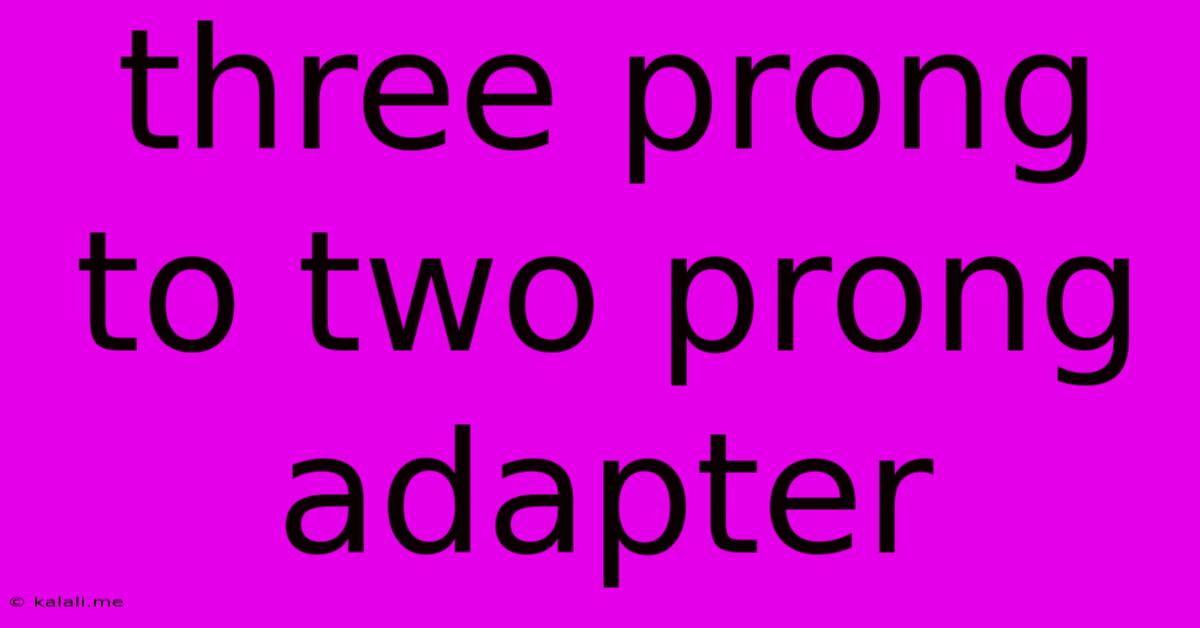Three Prong To Two Prong Adapter
Kalali
May 21, 2025 · 3 min read

Table of Contents
Three-Prong to Two-Prong Adapter: Safety, Legality, and Alternatives
Are you struggling with a three-prong appliance and a two-prong outlet? This common dilemma often leads people to seek a quick fix: the three-prong to two-prong adapter. But before you plug in, understanding the implications of using this adapter is crucial. This article will delve into the safety concerns, legal aspects, and safer alternatives to using a three-prong to two-prong adapter.
What is a Three-Prong to Two-Prong Adapter?
A three-prong to two-prong adapter is a simple device that allows you to connect a grounded appliance (three-prong plug) to an ungrounded outlet (two-prong). It essentially bypasses the grounding pin, connecting only the hot and neutral wires. While seemingly convenient, this bypass removes a crucial safety feature.
The Dangers of Bypassing Grounding:
The third prong, or ground pin, is a vital safety mechanism designed to protect you from electrical shocks. It provides a path for excess current to flow directly to the ground, preventing dangerous voltage buildup in the appliance's metal casing. Using a three-prong to two-prong adapter removes this crucial protection. If a fault occurs within the appliance, the metal casing could become energized, posing a serious risk of electric shock. This is especially hazardous with appliances that use water, like hair dryers or kitchen appliances, significantly increasing the risk of electrocution.
Legality and Code Compliance:
The use of three-prong to two-prong adapters is often a subject of building codes and electrical safety regulations. While not universally banned, many jurisdictions discourage or restrict their use, particularly in situations involving high-power appliances. It's crucial to check your local electrical codes and regulations. Using an adapter where it is prohibited could void insurance policies and, in extreme cases, lead to legal repercussions.
Safer Alternatives to Three-Prong to Two-Prong Adapters:
Instead of using a three-prong to two-prong adapter, consider these safer alternatives:
- Replacing the Outlet: The most effective and safest solution is to have a qualified electrician replace your two-prong outlets with three-prong grounded outlets. This ensures the proper grounding of your appliances, eliminating the safety hazard entirely. This is the recommended and safest long-term solution.
- Using a GFCI Outlet: A Ground Fault Circuit Interrupter (GFCI) outlet is a specialized outlet that detects imbalances in current and quickly shuts off power, minimizing the risk of electrocution. While it doesn't replace grounding, it offers additional protection.
- Using Appliances with Two-Prong Plugs: If possible, choose appliances that come with two-prong plugs, eliminating the need for an adapter altogether. However, ensure these appliances are designed to operate safely without grounding.
- Power Strips with Grounding: Several power strips available in the market come with three-prong inputs and multiple two-prong outputs. Although not ideal for high power appliances, these offer a better alternative to using a direct adapter.
Conclusion:
While three-prong to two-prong adapters provide a seemingly simple solution, the inherent safety risks far outweigh the convenience. Prioritizing electrical safety is paramount. Consider the safer alternatives discussed above to protect yourself and your family from the dangers of electrical shocks and potential fire hazards. Always consult with a qualified electrician for any electrical work in your home, ensuring compliance with local codes and regulations. Remember, safety should always be your top priority.
Latest Posts
Latest Posts
-
Difference Between Ping Pong And Table Tennis
May 21, 2025
-
What Is Semi Sweet Chocolate In Uk
May 21, 2025
-
Boiler Loses Pressure When Heating Is Off
May 21, 2025
-
How To Stop Moisture Coming Through Concrete Floor
May 21, 2025
-
Why Is The Paint Peeling Off The Wall
May 21, 2025
Related Post
Thank you for visiting our website which covers about Three Prong To Two Prong Adapter . We hope the information provided has been useful to you. Feel free to contact us if you have any questions or need further assistance. See you next time and don't miss to bookmark.